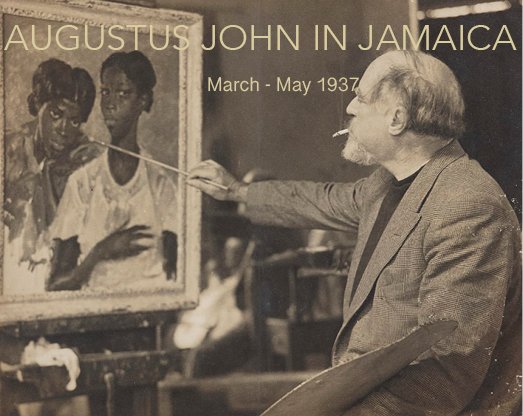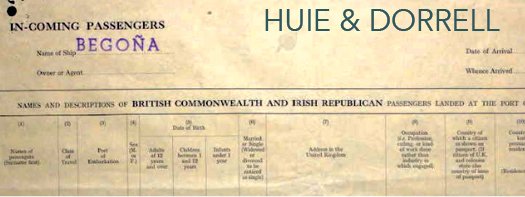Albert Huie (1920-2010)
Dorrell 🔴
Oil on Hessian Canvas
Dated and Signed: “Huie 19/11/42”
Size: 565 x 465mm (22¼ x 18¼”)
The following painting has a reasonable claim to be Jamaica’s 1st post-colonial portrait. It was painted on 11th November 1942 by the largely self-taught Albert Huie, who had moved to Kingston in 1936 to pursue a career as an artist. From decorating ceramics on street stalls, to demanding an audience with the secretary of the Jamaican National Institute in 1937, his artistic rise over the next few years coincided with Jamaica’s own rise from overseas dependency to a largely self-sufficient island, seeking independence in all its forms.
Huie attributed some of his early success to the 2nd World War and to the wealthy collectors who could no longer travel back and forth between Europe and the Caribbean. Jamaica’s growing political independence might be explained by the same forces, resulting from the breakdown in communications between Britain and her distant colonies during the war.
Dorrell, an adopted 15-year-old orphan typifies this rising self-confidence. Huie painted many portraits during these early years, but overwhelmingly they portray the affluent colonial classes. This is perhaps the only time where he was paid to paint a local orphan.
The portrait is painted on the coarse hessian canvas native to the island. It has likely been repurposed from one of the ‘crocus’ bags used across the Caribbean to carry flour, rice, sugar and other raw materials. Such bags are invariably associated with slavery and colonialism, with a long history of being recycled into anything from pillowcases and bedsheets - to uncomfortable, if hard wearing garments.
It is a small but significant detail, with almost redemptive implications. Huie’s ancestors might have spent their lives bearing the strains of these sacks, he would use them as a support for his portraits.
In the beginning I bought enamels in small tins from a hardware store and this was the medium I used to paint The Dancers after I had observed the scene in a downtown piano bar. Not long afterwards, I took this painting along with a couple others and my sketches, to the Institute of Jamaica to show them to Delves Molesworth. I was almost thrown out of the Institute. Mr. Molesworth himself interceded, looked at what I had brought to show him and expressed an interest. He invited me to his house and commissioned a portrait to be done of his wife. During this time he began introducing me to his circle of friends, which included the Manleys.
Albert Huie, recalling his meeting with Hender Delves Molesworth 1937
“he [John] would go into a bar, drink rum... and observe. This character was out in the rays of sunlight studying the colours... Come to England, he told me: I have a house in Kent where I can put you up.”
Carl Abrahams (1913-2005)
Albert Huie - National Library of Jamaica.
Augustus John arrived in Jamaica in March 1937 and remained for just over 2 months. This period has generally been seen from John’s side; Jamaica revitalised an ailing career and he returned to painting with a newfound vigour. What is now becoming clearer is the rousing effect that he had on the artistic life of Jamaica.
Unknown Jamaican Girl” 1937 - Augustus John (1878-1961) (Tate Britain)
It’s difficult to know John’s direct dealings with Huie; though the Jamaican art historian Veerle Poupeye describes how his “sensitive portraits of black Jamaican girls certainly inspired Albert Huie.” We also know that John was instrumental at the same time in convincing the cartoonist Carl Abrahams (1911-2005) – a contemporary of Huie’s - to pursue a career as a painter. Abrahams later recalled how John ‘was the first to identify himself with us [the Jamaican painters]’ and it is interesting that Huie revealed himself to the Jamaican National Institute in 1937 the year of John’s visit.
This curious artistic exchange, where Jamaica gave inspiration to a famous painter entering the twilight of his career, while he in turn offered encouragement to talented painters struggling on the periphery of a large empire, must surely rank as one of the most interesting and unexplored chapters in the history of British Art.
During John’s time in Jamaica, he made great efforts to seek out the locals and to familiarise himself with the climate and scenery. Nevertheless, the painter Neville Lewis (1895-1972) described how his pictures from this period were “magnificently drawn” but that “the skin was more or less a brown monochrome”, lacking the “variety of reflections and highlights and changes of tone.” Lewis, an early disciple of John’s, had grown up in South Africa and had spent much of his early life there, observing a varied population which included the indigenous Khoisan, Bantu tribes that had migrated from central Africa, as well as Europeans, Malays and Indians.
The art historian Edward Lucie Smith, suggests that Huie had a similar “insight into the character of his sitters.” He also describes how the innumerable flicks of the brush which make-up Huie’s early works capture the specific light of the Caribbean and how it sparkles on the surfaces it touches. Huie’s subjects were therefore “not the manifestation of an exotic tropical culture”, but the direct portrayal of an island that he knew and understood in ways which no visiting artist could.
‘The Blue Pitcher’ - Albert Huie (1920-2010) (Prev. Cider House Galleries)
Albert Huie’s artistic odyssey in the years after painting Dorrell is astounding. He became the first Jamaican artist to hold a solo exhibition in 1943, and his 1944 scholarship to study in Canada threw him into contact with two of the earliest exponents of The Group of Seven, a national art movement that found European artistic norms unsuited to portraying Canadian scenery.
Huie applied a similar sentiment in his Jamaican landscapes, concluding there were “two dominant lights: the morning is silver, later, it is gold.”
By 1947 the artistic cycle begun with John’s visit to Jamaica was nearing completion; the Government of Jamaica sponsored a joint exhibition of Huie’s work at Foyle’s Gallery in London. His pictures were well received and Huie received a scholarship to study at the Leicester College of Art. Preferring to be in London, he wrote to his friend and mentor, Hender Delves Molesworth, now at the V&A, who helped him to transfer to the Camberwell School of Art.
Dorrell, might refer to Dorrell Benjamin, whose more humble journey, saw him arrive in England at the end of the Windrush generation. He was born 24th June 1927 in Moores, Clarendon, Jamaica, to William Samuel Benjamin and an unknown mother. He was later adopted by Alfred John Buckley (1907-1991), who arrived in Jamaica in late 1937. The 1958 passenger list of the Begoña describes him as a ‘labourer’ and gives an address at 18 Hutton Road, Handsworth, Birmingham. Little more can be found about his life in England, though subsequent records are often misspelt ‘Darrell.’ He seems to have remained in Birmingham, marrying in October 1961 and dying in the same city on 6th September 2002.




